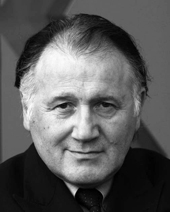|

Music by Cellular Algorithms
Music is defined as time-based art. This conception is expressed by the intervall theory which is the dominant theory for Western music. On the lines of a score (invented by Guido Arezzo, 1025) notes are placed one after another as a temporal sequence. With the help of Clifford Algebra and Grassmann Vector Spaces it can be demonstrated that a single topological sequence can be transformed into different temporal sequences. By this method music becomes part of topology, space-based art. The notes of a score can be independent as points and numbers. These numbers are part of a field, topological neighbours. The Game of Life by John Conway (1970) is an ideal field to reflect this new conception of music. The Game of Life is a cellular automaton and serves as method of composition. It consists of a regular grid of cells, each in one of a finite number of states, such as "On" and "Off". The grid can be in any finite number of dimensions. For each cell, a set of cells called its neighborhood is defined relative to the specified cell. For example, the neighborhood of a cell might be defined as the set of cells a distance of 2 or less from the cell. The cells are treated as notes and can be calculated or »composed« according to the rules of the Game of Life. Naturally this process can also be interpreted in a rather free way.
Biographie
Peter Weibel studied literature, medicine, logic, philosophy and film in Paris and Vienna and is Chairman and CEO of the ZKM | Center for Art and Media, Karlsruhe. Since 1984 he is professor at the University of Applied Arts Vienna. From 1984 to 1989 he was head of the digital arts laboratory at the Media Department of New York University in Buffalo, and in 1989 founded the Institute of New Media at the Städelschule in Frankfurt-on-Main, which he directed until 1995. Between 1986 and 1995 he was in charge of the Ars Electronica in Linz. He commissioned the Austrian pavilions at the Venice Biennale from 1993 to 1999. In 2007 he received the Honorary Doctorate by the University of Art and Design Helsinki and in 2008 he was Artistic Director of the Biennial of Sevilla (Biacs3). From 2009 to 2012 he is Visiting Professor at the University of New South Wales, Sydney, Australia. He is also the Artistic Director of the Fourth Moscow Biennial of Contemporary Art. He received numerous awards such as the French Order Officier dans l'Ordre des Arts et des Lettres (Order of Arts and Literature) in 2008 and the Österreichisches Ehrenkreuz für Wissenschaft und Kunst 1. Klasse in 2010.
|


